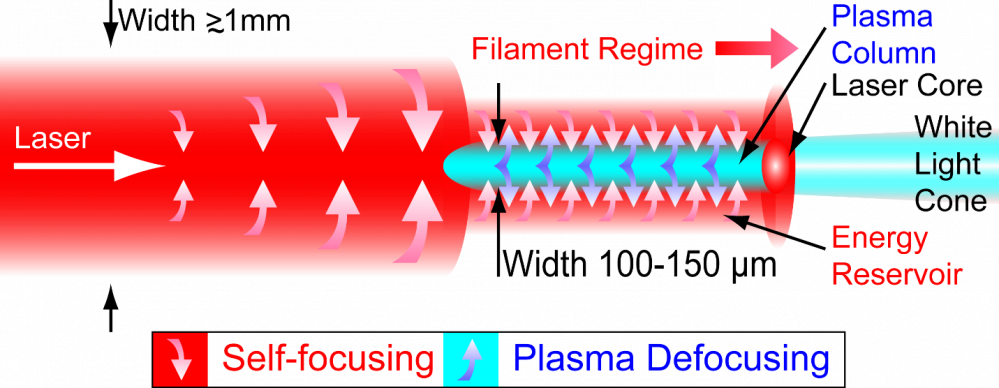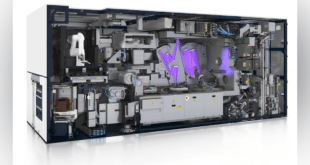The Laser Directed Energy Weapons (DEWs) offer a transformational ‘game changer’ to counter asymmetric and disruptive threats, while facing increasingly sophisticated traditional challenges. Laser technology provides major advantages for military applications over kinetic weapons due to High precision and rapid on-target effect, precise and scalable effects, avoidance of collateral damage caused by fragmenting ammunition, Low logistics overhead and minimum costs per firing.
The development of laser weapons requires many critical technologies, first is development of lasers capable of generating powers in kilowatts to megawatts range to be able to produce useful damage effects on the target. For instance to destroy anti-ship cruise missiles would require a beam of 500 kilowatts and demand megawatts of power.
Current high energy laser (HEL) weapon systems primarily consist of continuous wave (CW) laser sources with output powers in the kilowatts. These kilowatt-class CW laser systems predominantly engage targets via absorption of light; either causing the target to burn and melt or overwhelming optical sensors with high intensities. Thanks to the emergence of diode and fiber laser technology, these laser systems have grown increasingly ruggedized to the point they have been integrated onto platforms ranging from ground to sea.
There are mode-locked lasers emitting ultrashort pulses, i.e. light pulses with durations of femtoseconds or picoseconds: mostly below 100 ps, often even well below 100 fs. A more precise but less common term is actually ultrashort pulse lasers; such lasers utilize ultrafast processes and emit light with very fast changes of optical power. Typical pulse repetition rates of ultrafast lasers are of the order of 100 MHz, but it is also possible to have only a few megahertz or many gigahertz.
Ultrashort pulse lasers (USPLs) for directed energy applications
Researchers from across the U.S. DoD seek to use the unique properties of ultrashort pulse lasers (USPLs) for directed energy applications. While the laser technology for a fielded system remains on the horizon, the fundamental physics and material science can be researched today with current USPLs. Given limited resources, the DoD research offices have complementary internal programs with the support of academic and industrial research, including numerous multidisciplinary university research initiatives (MURIs).
The result has been a rapid acceleration in the knowledge base of USPL effects and remarkable improvements in the modeling capabilities. Simultaneously, improvements have occurred in USPL technology to meet DoD requirements for force application and force protection. This article highlights some of the efforts, primarily in the basic research realm, where the DoD’s collaborative effort is making a significant contribution to this field.
While most CW lasers simply melt targets, USPL systems are able to neutralize threats via three distinct mechanisms: ablation of material from the target, the blinding of sensors through broadband supercontinuum generation in the air, and the generation of a localized electronic interference used to overload a threat’s internal electronics.
Even the propagation of light from a USPL system holds unique advantages. The sheer amount of intensity in a terawatt pulse laser is able to cause a non-linear effect in air resulting in a self-focusing filament. These filaments propagate without diffraction, providing a potential solution to the negative impact turbulence has on beam quality when propagating a conventional CW laser system.
One particularly interesting effect of USPLs interacting with a transparent propagation medium (air, water, glass, etc.) is filamentation. Filaments arise when the intensity of USPLs cause a small increase in the second-order nonlinear index of refraction, which acts like a slow lens. As the pulse focuses itself, the intensity increases, thereby increasing the self-focusing to the point where the medium is ionized. In air, the free electrons generated by ionization have their own nonlinear effect: defocusing. If the self-focusing can be balanced by the defocusing and losses from ionization, a stable filament can be created in which the cross section of the laser (typically a diameter of 100 μm) is maintained over long distances even up to hundreds of meters.

Figure 1: Filamentation Where an Intense Laser Self-Focuses to Generate a Defocusing Plasma Column. The Self-Focusing Energy Reservoir and Defocusing From the Plasma, Accounting for Losses, Are Balanced in the Filament Regime. At the End, a Narrow Cone of White Light Continuum Is Generated (Source: Anthony Valenzuela).
A common hallmark of filamentation is the generation of a narrow cone of supercontinuum radiation that can span, for a driving near-infrared (NIR) laser, the spectrum from ultraviolet (UV) to mid-infrared (IR) and beyond. A clear advantage of a filament is the ability to affect matter in a consistent way without needing to know the precise location of a target.
Another advantage from the consistency of filaments is the ability to create a channel that assists in the creation of harmonics of the laser frequency, leading to ultrashort generation of extreme-UV (XUV) and soft x-rays as well as attosecond (10-18 s) pulses. These pulses are seen as unique tools to interrogate matter with immense precision from a relatively compact source.
While efforts to determine how filaments propagate and interact with targets have made significant gains, the applicability of this technology to military applications has been limited by the laser technology. Most systems today with adequate energy use titanium:sapphire (Ti:S) gain media and chirped pulse amplification to achieve the required intensities. This technology provides a trade-off between pulse energy and pulse repetition rate. Additionally, the complexity and sensitivity of this technology require highly skilled maintenance and strict control of the environment.
Nonetheless, as demonstrated by the European Teramobile project, this maintenance/control can be accomplished in a transportable system. Recent advances in ultrashort pulse fiber lasers are seen as a significant game changer that could lead to both high pulse energies and higher repetition rates, with the possible added advantage of operating at “eye-safe” wavelengths. This is commensurate with increased research moving beyond Ti:S technology in the NIR to USPLs that operate across a wide range of IR wavelengths where transmission in air is actually better than at visible wavelengths
NRL and AFRL have also designed and constructed unique experimental facilities to characterize USPL propagation through turbulence. These facilities include NRL’s propagation laboratory (30–90-m range), AFRL’s PHEENIX laser propagation range (180– 540-m range), and the propagation range at the Naval Surface Warfare Center Carderock Division (NSWCD) (~1-km range). These facilities use a turbulence generator that consists of several heated wires that extend the length of the propagation path and generate Kolmogorov turbulence conditions characteristic of the atmosphere. At the longer-range facilities, the turbulence generator can controllably create optically weak (Rytov variance <<1) to optically strong (Rytov variance >5) turbulence
Differences in lethality as well as propagation mechanisms makes USPL technology one of particular interest for numerous mission sets.
Army Requirements
The Army is preparing the warfighter for a future battlefield with rapidly modernizing militaries while new threats and gaps are emerging. CW lasers provide solutions to many of these problems but due to their fundamental different natures, lasers with pulse widths in the range of femtoseconds provide unique tactical capabilities due to their rapid discharge of enormous power.
The service posted a notice for the prospective new weapon at the Pentagon’s Small Business Investment Research website, calling the weapon the Tactical Ultrashort Pulsed Laser for Army Platforms. The Army believes it can merely aim the laser at a drone to both damage it and fry its electronic guts.
This Feb 2021 call aims to develop an USPL that is ruggedized enough to begin testing in relevant Army environments. Over the last two decades, femtosecond lasers have gone from requiring dedicated buildings at national laboratories to sitting on academic optics tables across the country. These USPL advancements, while promising, still have many hurdles to overcome in SWaP, relevant operating environments, and consistent mass manufacturing.
This solicitation looks for a solution to achieve the parameters listed below in one prototype: • Wavelength: Wavelengths that transmit through the atmosphere • Average Power Output: Threshold: 20 W; Objective: 50 W • Pulse Peak Power: Threshold: 1 TW; Objective: 5 TW • Pulse Width: Threshold: 200 fs; Objective: 30 fs • Repetition Rate: Threshold: 20Hz; Objective: 50Hz . Beam Quality (M2): Threshold: 2.0, Objective 1.5
US Airforce requirements
U.S. Air Force laser weapons experts are reaching out to industry for enabling technologies that could lead to ultra-short-pulse fiber lasers for future directed-energy weapons. Officials of the Air Force Research Laboratory Directed-Energy Directorate at Kirtland Air Force Base, N.M., issued a request for information (RFI-RDKP-2021-0003) in July 2021 for the Ultrashort High Average Power Technology Availability project.
Air Force researchers want information from industry concerning the maturity, availability, and rough estimate of cost of an ultra-short-pulse fiber laser system for future military applications that produce high average power at a high repetition pule rate.
Researchers interested in a ultra-short pulse laser fiber laser weapon capability for a future acquisition program that will use an ultra-short-pulse laser fiber laser to destroy or disable targets, as well as capitalize on non-linear propagation for high laser intensities at the target. Proposed solutions should be low size, weight, and power consumption (SWaP), and may use either a monolithic or partly free-space architecture based on single-laser amplifier or beam-combining parallel amplifiers.
Air Force experts want to find out about fiber laser systems that are available or being developed that produce average power of more than 0.5 kilowatts at pulse repetition frequencies of more than 5 kHz, and use pulse widths narrower than 5 picoseconds. Such qualities could lend themselves to radiation bursts and particle beams able to disable or destroy military targets.
The following applications of ultra-short-pulse lasers have been considered by the Navy:
- Long range directed energy, exploiting nonlinear focusing to overcome diffraction. This could include both direct target damage or target “softening” for a high-energy laser attack.
- Long-range target impairment/disruption. An example is high-power RF generation at the target.
- Long range detection and composition probing of an atmospheric area of interest. Examples include detection of harmful aerosols and bio-agents from a safe distance, where one could distinguish between bio-aerosols and natural background aerosols.
- Filamentation for triggering and/or guiding of energy or electromagnetic waves.
- In Homeland-Security applications, there has been discussion of the use of laser Compton scattering of a high-peak-power laser from a high-energy electron beam to generate tunable, narrow-linewidth gamma rays. These in turn can be used as a probe to detect, say, fissionable materials in transport vehicles. An example is the Department of Homeland Security’s FINDER project for high-confidence detection of nuclear materials to enhance port security.
 International Defense Security & Technology Your trusted Source for News, Research and Analysis
International Defense Security & Technology Your trusted Source for News, Research and Analysis

